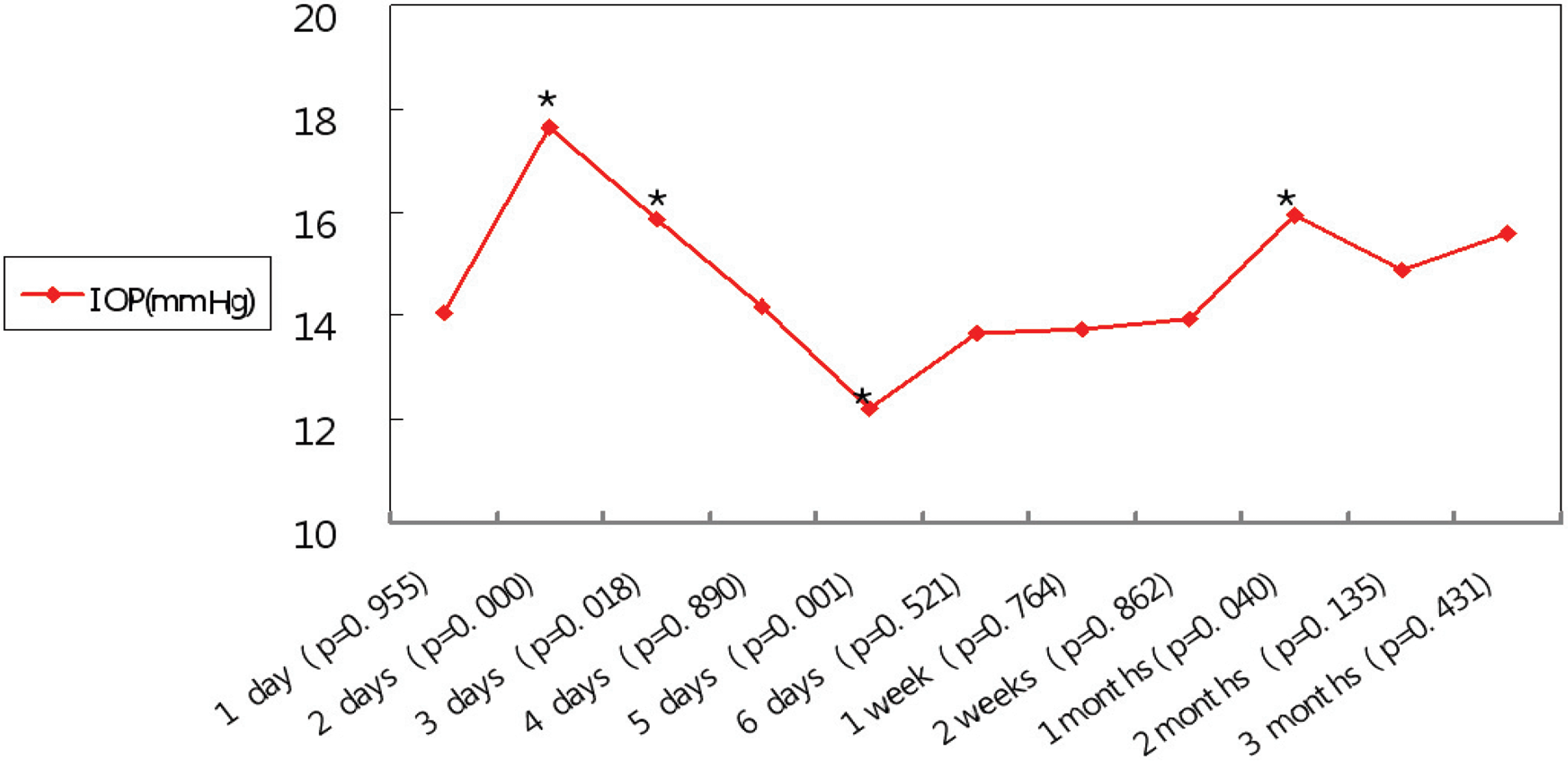Abstract
Purpose
To report the relationship between the extent of rupture of the trabecular meshwork and intraocular pressure changes in traumatic hyphema patients.
Methods
Ninety-five trabecular meshwork rupture patients were selected from a group of traumatic hyphema patients. Identification and measurement of the rupture of the trabecular meshwork were performed by gonioscopy, and intraocular pressure was measured by Goldmann applanation tonometry until 3 months after the trauma.
Results
There were statistically significant differences of IOP between the traumatic eyes and the contralateral eyes at day 2, 3, 5, and 1 month ( p=0.000, 0.018, 0.001, 0.040, respectively). IOP was highest at the 2nd day post-trauma, and dropped by the 5th day, after which it rose slightly. The relationship between the extent of trabecular meshwork rupture and the difference of IOP was positive at the 2nd day post-trauma (r=0.259) and negative at the 6th day post-trauma (r=-0.296); these differences are statistically significant ( p=0.020, p=0.041, respectively).
Go to : 
References
1. Farber MD, Fiscella R, Goldberg MF. Aminocaproic and versus prednisone for the treatment of traumatic hyphema: a randomized clinical trial. Ophthalmology. 1991; 98:279–86.
2. Berke SJ. Post-traumatic glaucoma. Ophthalmology. 2nd. London: Mosby;2004. p. 1518–21.
3. Blanton FM. Anterior chamber angle recession and secondary glaucoma. A study of the after effects of traumatic hyphemas. Arch Ophthalmol. 1964; 72:39–43.
5. Kaufman JH, Tolpin DW. Glaucoma after traumatic angle recession. A ten-year prospective study. Am J Ophthalmol. 1974; 78:648–54.

6. Thiel HJ, Aden G, Pulhorn G. Changes in the chamber angle following ocular contusions. Klin Monatsbl Augenheilkd. 1980; 177:165–73.
7. Wolff SM, Zimmerman LE. Chronic secondary glaucoma associated with retrodisplacement of iris root and deepening of the anterior chamber angle secondary to contusion. Am J Ophthalmol. 1962; 54:547–62.
9. Mortensen KK. Changes in anterior chamber depth and angle-recession:late complications to ocular contusion. Acta Ophthalmol (Copenh). 1978; 56:867–82.
10. Salmon JF, Mermoud A, Ivey A. . The detection of post-traumatic angle recession by gonioscopy in a population- based glaucoma survey. Ophthalmology. 1994; 101:1844–50.
12. Canavan YM, Archer DB. Anterior segment consequences of blunt ocular injury. Br J Ophthalmol. 1982; 66:549–52.

13. Campbell D. Traumatic glaucoma. Eye trauma. 1st. St. Louis: Mosby Year Book;1991. p. 117–25.
15. Petit T, Keates E. Traumatic cleavage of the chamber amgle. Arch Ophthalmol. 1963; 69:60–6.
16. Tonjum AM. Intraocular pressure and facility of outflow late after ocular contusion. Acta Ophthalmol. 1968; 46:886–908.
18. Herschler J. Trabecular damage due to blunt anterior segment injury and its relationship to traumatic glaucoma. Trans Am Acad Ophthalmol Otolaryngol. 1977; 83:239–48.
19. Endo S, Ishida N, Yamaguchi T. Tear in the trabecular meshwork caused by an airsoft gun. Am J Ophthalmol. 2001; 131:656–7.

20. Shields M. Glaucoma associated with ocular trauma. Textbook of glaucoma. 5th ed Baltimore: Williams and Wilkins;2005. p. 406–7.
21. Tönjum AM. Intraocular pressure and facility of outflow, late after ocular contusion. Acta Ophthalmol. 1968; 46:886–908.

22. Tonjum AM. Intraocular pressure disturbance, early after ocular contusion. Acta Ophthalmol. 1968; 46:874–85.
Go to : 
 | Figure 1.Goldmann 3-mirror contact goniolens photograph. (A) Note the circumferentially full thickness trabecular meshwork rupture (arrowhead). Angle recession (deep tear into ciliary body) also present. (B) Uveal meshwork rupture combined with angle recession (arrowhead) is seen in the inferior view. |
 | Figure 2.Serial change of mean IOP after blunt trauma; * p-value<0.05 by One-sample T-test. |
Table 1.
Clinical characteristics of the subjects
Table 2.
Extent of trabecular meshwork rupture
| Extent (°) | No.(%) of patients |
|---|---|
| 0~90 | 20 (21) |
| 120~180 | 33 (35) |
| 210~360 | 42 (44) |
Table 3.
Mean IOPs and IOP differences in patients with trabecular meshwork rupture
| Time from trauma | Mean IOP (mmHg) | IOP difference (mmHg) | p-value |
|---|---|---|---|
| 1 st day | 14.06±2.64 | -0.02 | 0.955 |
| 2 nd day | 17.62±6.91 | 3.54 | 0.000* |
| 3 rd day | 15.87±6.42 | 1.79 | 0.018* |
| 4 th day | 14.17±5.60 | 0.09 | 0.890 |
| 5 th day | 12.20±4.38 | -1.88 | 0.001* |
| 6 th day | 13.66±4.86 | -0.42 | 0.521 |
| 1 week | 13.74±6.64 | -0.34 | 0.764 |
| 2 weeks | 13.92±6.46 | -0.16 | 0.862 |
| 4 weeks | 15.96±6.01 | 1.88 | 0.040∗ |
| 2 months | 14.89±3.29 | 0.81 | 0.135 |
| 3 months | 15.58±6.37 | 1.50 | 0.431 |
Table 4.
Correlation between trabecular meshwork rupture extents and IOP differences
| Time from trauma | Correlation coefficient | p-value |
|---|---|---|
| 1 st day | 0.139 | 0.232 |
| 2 nd day | 0.259 | 0.020* |
| 3 rd day | 0.031 | 0.789 |
| 4 th day | 0.035 | 0.782 |
| 5 th day | -0.090 | 0.510 |
| 6 th day | -0.296 | 0.041∗ |
| 1 week | 0.124 | 0.400 |
| 2 weeks | 0.020 | 0.893 |
| 4 weeks | 0.079 | 0.638 |
| 2 months | -0.286 | 0.368 |
| 3 months | -0.080 | 0.865 |




 PDF
PDF ePub
ePub Citation
Citation Print
Print


 XML Download
XML Download